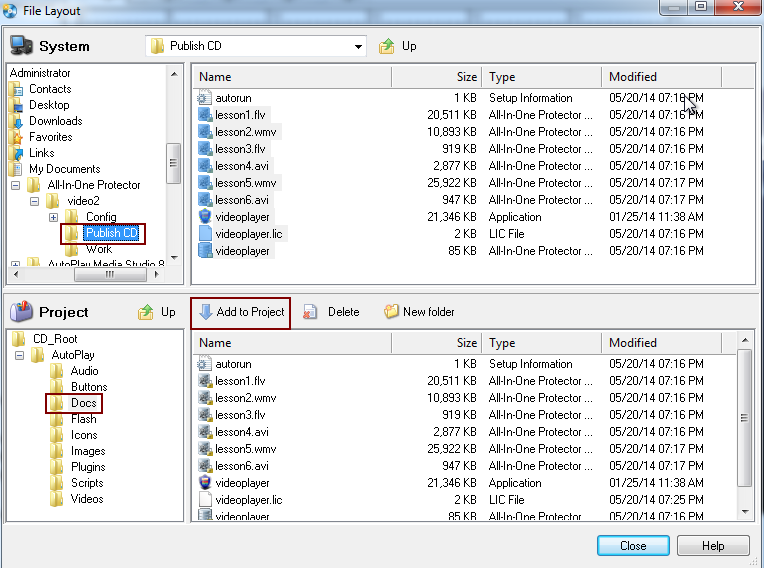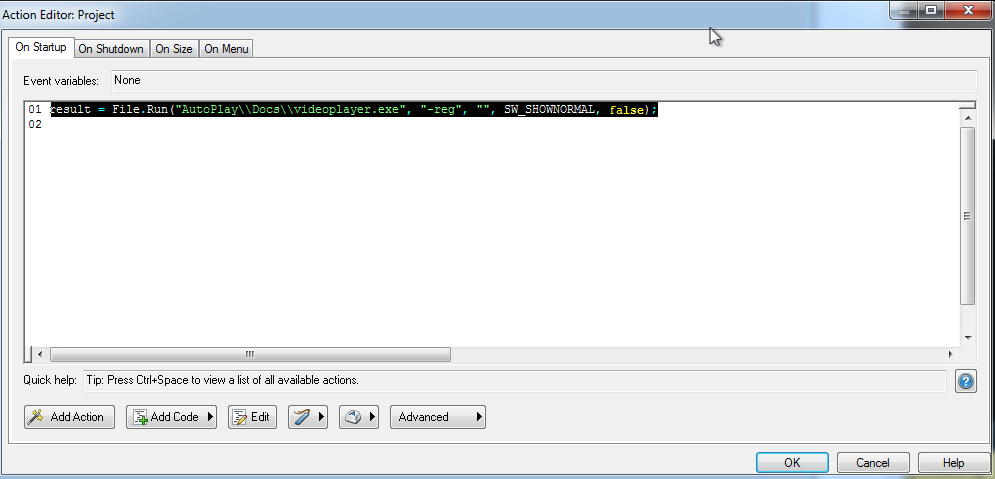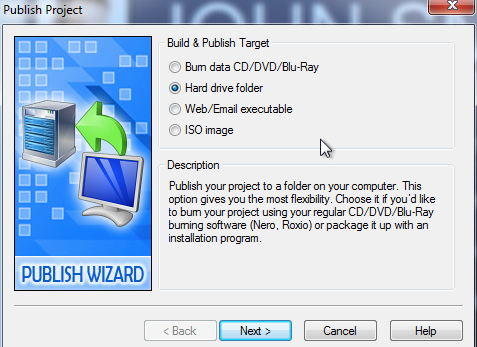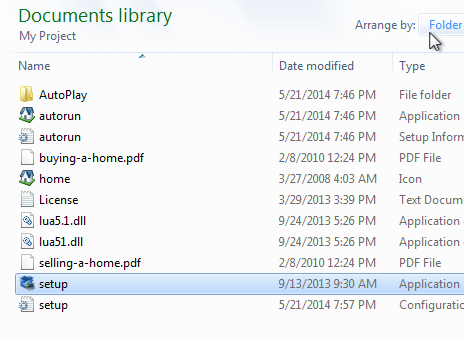
All-In-One Protector 8
This application can be downloaded at http://www.indigorose.com . The test was done with version 8.2
The menu application creates an EXE autostart file for the menu. This file (the menu application) is on the CD or in the download link and it is not protected (don't import it in the All-In-One Protector database).
Step 1 - Add the Publish All Media folder to the AutoPlay Media Studio project
You have to add all files which should be included in the Autoplay Project. Select the menu Project, File Layout. In the upper part of the screen open the Publish All Media folder, select all files and add the files to the docs folder.

Step 2 - Define the file to start for each button
Now create your menu and add a button for each file you want to start, e.g. a button with Tutorial 1, Tutorial 2 etc. Then right click on the button and select Properties.
In the TAB Quick Action - select: Action to run: Open Document. In the line Document to open add the path and the name of the protected document to open. All All-In-One Protector files have a special extension - see file names
In the screenshot below, the file lession1.flv.mpvideo is launched.

Step 3 - Define a launch option when the menu is started
The All-In-One Player has to register the All-In-One Protector file extension. This is done done using an action. Select the TAB Project, then Actions.
Copy the following line
result = File.Run("AutoPlay\\Docs\\videoplayer.exe", "-reg", "", SW_SHOWNORMAL, false);
Where videoplayer.exe is the name of the All-In-One Player.

Step 4 - Build the CD or EXE file for download
In the menu, select Publish, Build. Then select Hard drive folder to test the project.

All your files are now copied from the Publish All Media folder to this new CD folder. Click on Autorun.exe to test everything.
If you have done all tests, you could directly burn a CD.
Do not use option "Web / EMail executable". If you want to create a download version use the Installation Manager (see chapter below).
 If you make any changes in the All-In-One Protector project, you have to rebuild the CD with AutoPlay Media Studio
If you make any changes in the All-In-One Protector project, you have to rebuild the CD with AutoPlay Media Studio
Using Installation Manager
If the complete CD content should be copied to the hard disk of the user or if you want to create a download version, you can use the Installation Manager of All-In-One Protector. Copy the file setup.exe and setup.ini to the installation directory created by AutoPlay Media Studio.

The general settings are described in the chapter Installation Manager, configuration file Setup.ini. There are special settings required as all subfolders have to be copied. After the installation and also when clicking on the desktop icon, the menu and not the All-In-One Player has to be started.
Find below all differing settings marked in red.
[Setup]
AppName=My Program
AppVersion=3.0
AppPublisher=Universal Software
DefaultDirName=My Program
DefaultGroupName=My Program
[Files]
BinFolder=\autoplay\docs
Exe-Start-Application=Autorun.exe
exe-Filename=\autoplay\docs\mycourse.exe (All-In-One Player application)
mmf-Filename=\autoplay\docs\mycourse.aipfile (file could also have a different extension - see file names)
lic-Filename=\autoplay\docs\mycourse.lic
ico-Filename=\autoplay\docs\mycourse.ico
readme-ces=
readme-dan=
readme-deu=
readme-dut=
readme-enu=
readme-esp=
readme-fra=
readme-ita=
readme-nor=
readme-por=
additional1=autoplay\*
additional2=autorun.exe
additional3=autorun.inf
additional4=*.dll
additional5=
additional6=
additional7=
additional8=
additional9=
additional10=
additional11=
additional12=
additional13=
additional14=
additional15=
additional16=
additional17=
additional18=
additional19=
additional20=
additionalfolder1=autoplay
additionalfolder2=
additionalfolder3=
additionalfolder4=
additionalfolder5=
additionalfolder6=
additionalfolder7=
additionalfolder8=
additionalfolder9=
additionalfolder10=
additionalfolder11=
additionalfolder12=
additionalfolder13=
additionalfolder14=
additionalfolder15=
additionalfolder16=
additionalfolder17=
additionalfolder18=
additionalfolder19=
additionalfolder20=
[Options]
InstallPDFViewer=false
OverwriteLicenseFile=true
RunPlayerAfterInstall=false
RunPlayerAfterInstallNetwork=true
RunBeforeInstall=
RunBeforeInstallNetwork=
RunAfterInstall=autorun.exe
RunAfterInstallNetwork=
[USB]
use-usb=true
[ProgManGroup]
ShowLicenseInfo=true
ShowLicenseInfoNetwork=
ShowReadmeFile=false
DBFileName01=
EmbeddedDBFileDesc01=
EmbeddedDBFileName01=
Installation Manager
To install a download or a CD version to the hard disk including adding a desktop icon or program manager group entry, use the Installation Manager.
Create Download Version
In case you want to deliver one EXE file as a download version see chapter: How to create a download version in EXE format?
Otherwise just ZIP all files.
 Also see: How can I share my files using a download link?
Also see: How can I share my files using a download link?
